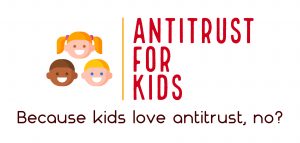Author: Aaron Gott
There are a lot of lessons you can learn from Wonka. It’s a story about how ingenuity, determination, selflessness, and teamwork can overcome the oppressive adversity of a system that serves entrenched interests.
But it’s also a story about a chocolate cartel. And that offers its own lessons, too. Just ask my four kids, who now understand what I do all day (though I may have overplayed the chocolate-related aspect).
In fact, the whole plot of Wonka revolves around the machinations of this market-dominating chocolate cartel. It’s almost as if the folks over at Warner Bros. Pictures took inspiration from our Antitrust for Kids series and (surely inadvertently) left us out of the credits.
For those who haven’t seen it: Wonka is essentially the origin story of the Willy Wonka from 1971’s Willy Wonka & the Chocolate Factory. Wonka, played by Timothée Chalamet, comes to town with the intent to realize his dream of owning a chocolate shop in a ritzy plaza called the Galeries Gourmet. With little money to his name—twelve silver sovereigns that are all spent by the end of the first tune—he sets out to sell his chocolate on the street the following day. A crowd gathers, and the owners of three preeminent chocolate shops, led by Paterson Joseph’s Slugworth, at the Galeries Gourmet notice.
Spoiler Alert!: in this post, I’m talking about Wonka and there may be some spoilers. So if you haven’t seen it, go watch it, and then come back and read this post.
We learn that these three chocolatiers are, despite identifying themselves as three “fierce rivals,” in fact, the members of a chocolate cartel that has the entire market locked down. And just as soon as upstart Wonka begins trying to sell his chocolate, the cartel goes to work to prevent this competitive threat from upending its lucrative arrangement. Or as the cartel puts it, “If we don’t / get on top of this / we’ll go bust / chocopocalypse! / we’ll cease to exist.”
What follows in Wonka is not only a lot of catchy numbers, but also a step-by-step guide into the workings of a successful price-fixing cartel.
- Control Price by Controlling Supply
Soon after the members of the chocolate cartel are introduced, we learn the strategy to which they owe their cushy, profitable position: while ostensibly fierce rivals to the outside world, each with their own shops, the chocolatiers actually pool their chocolate in a secret underground vault and strictly control the output so as to artificially depress supply, which ultimately raises prices in a market with pent-up demand.
This is a classic mechanism for a cartel to increase prices without explicitly fixing prices. Rather than attempt to set and discipline cartel members’ prices directly, which can be difficult to administer and is more easily detected by authorities, controlling supply (or production) lets the market do the work of raising prices through the hydraulic action of supply and demand. Output restrictions and price fixing are two sides of the same coin.
A classic example of output controls is the open-and-notorious oil conspiracy known as OPEC.
- Conceal Your Meetings and Communications
The chocolatiers’ secret underground vault isn’t just where they store their chocolate reserves; it’s also where they meet to discuss their nefarious business. The lair is underneath a Catholic church run by a frocked, chocoholic Mr. Bean on the take, and to get there, they simply go to a confessional booth, which has a secret elevator to the vault below.
Conspirators often take measures to conceal their communications and meetings, and while real-life cases do not usually involve such ostentatious means, they can still be elaborate. Some use code names and secret email addresses, while others might enlist a supplier to collect and distribute draft pricing announcements while she makes her sales rounds. Conspirators might even have a seemingly coincidental meeting at a charity golf tournament.
And while this cartel was meeting directly in its secret lair, it could have accomplished a similar scheme by integrating Father Bean as the hub of a hub-and-spoke conspiracy. Some notable recent cases have featured accusations of conspiracies facilitated through third-party data aggregators and technology service providers. That kind of conspiracy, though, isn’t quite as conducive to show-tune choreography.
- Keep Your Numbers Small
Another reason the chocolate cartel was so successful: it comprises only three competitors who dominate a market. It’s easier to form a cartel in a concentrated, oligopic market. And it’s easier to sustain one, too, for a few different reasons.
The more people who are in on a secret, the more likely that secret is going to get out. It’s important your cartel stays a secret, given that it’s a felony punishable by prison and often means civil liability far beyond what was made from the scheme. This is especially true because the U.S. Department of Justice Leniency Program provides incentives for cartel members to tell on their co-conspirators and cooperate with its investigations. So even if you trust your co-conspirators now, wait until one of them is acquired by a larger company with a strong antitrust compliance program or one of their employees decides to become a whistleblower if for no other reason than to protect their job.
Keeping your numbers small also means that it is less work to detect and punish “cheating” by cartel members, which is inevitable—if they’re willing to cheat the market, you can be sure they’ll cheat each other at every opportunity.
- Use the Law to Stop Upstart Competitors
In Wonka, local law forbids the sale of chocolate without a chocolate shop. As one of Wonka’s friends puts it, “You can’t get a shop without selling chocolate, and you can’t sell chocolate without a shop.”
This catch-22 is surely by design. The cartel instinctively calls the police on Wonka the very moment it recognizes him as a competitive threat. The cartel members even make friends with the chief of police—played by Keegan Michael Key—and bribe him with chocolate (and the promise of more) so that he dedicates himself to enforcing the law against Wonka.
Cartels often try to create and use legal barriers to prevent new competitors from gaining a foothold. In the United States, it’s a tale as old as interest group politics: lobby to create barriers to entry through either complex regulatory regimes or licensing schemes that make it harder for others to enter the market and compete against you. And then put your friends in government to enforce those laws with enthusiasm.
Something like this is what happened in North Carolina State Board of Dental Examiners v. FTC: as teeth whitening technology took off, dentists found it extraordinarily profitable. And when non-dentists started offering teeth whitening, the dentists used the state board (conveniently controlled by dentists) to reinterpret the dental scope of practice under state law and start going after non-dentists for the unlicensed practice of dentistry, even though teeth whitening is not actually dentistry.
- Scare Consumers Away From Non-Conspirator Rivals
The chocolate cartel also attempts to turn the market against Wonka. First, in front of a crowd comprising Wonka’s intrigued prospective customers, Slugworth declares his expert opinion: “Mr. Wonka, I have been in this business a very long time, and I can safely say, that of all the chocolate I have ever tasted, this is without doubt, the absolute 100% worst.”
Consumers still went wild for Wonka’s “hover chocolates” when Slugworth and his confederates started to float. But that victory was short-lived because of the already-in-motion cartel strategy of using the law against Wonka, which goes to show a successful cartel doesn’t usually rely on just one type of anticompetitive act to achieve its goals.
Later, after a montage of Wonka and his troupe turning to a pop-up retail strategy that allows him to both compete and successfully evade the police, Wonka finally has the financial resources to open a shop. And when he does, the chocolate cartel sabotages him by surreptitiously poisoning his confections with Yeti Sweat, which leads to rapid and uncontrollable vividly colored hair growth. With this, the cartel successfully turned the market against Wonka, and Wonka’s shop was literally destroyed.
Food tampering aside, this is classic group boycott behavior: a concerted effort by firms to persuade customers, suppliers, and other parties in the market not to do business with a rival firm whose competition imposes downward price pressure in the market.
- Reach an Illegal Noncompete Agreement
The chocolate cartel at one point convinces Wonka to agree not to compete in exchange for buying his and his friends’ freedom from their indentured servitude to Mrs. Scrubbit.
Paying competitors not to compete is illegal, but the important thing to note here is that it is illegal even if it is just one competitor paying off another. In fact, there is a whole class of “pay-for-delay” antitrust cases, which typically allege brand-name pharmaceutical companies suing generic makers for patent infringement, with the purpose of inducing a settlement whereby the generic makers agree not to introduce their competing products to the market for some period of time.
 The Antitrust Attorney Blog
The Antitrust Attorney Blog












